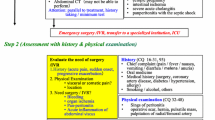Abstract
Of all the intra-abdominal solid organs, the liver is the most vulnerable to blunt abdominal trauma. The majority of liver ruptures present in combination with other abdominal or extra-abdominal injuries. Over the last three decades, the management of blunt liver trauma has evolved from obligatory operative to non-operative management in over 90% of cases. Penetrating liver injuries more often require operative intervention and are managed according to adult protocols. The greatest clinical challenge remains the timely identification of the severely damaged liver with immediate and aggressive resuscitation and expedition to laparotomy. The operative management can be taxing and should ideally be performed in a dedicated paediatric surgical centre with experience in dealing with such trauma. Complications can occur early or late and include haemobilia, intrahepatic duct rupture with persistent biliary fistula, bilaemia, intrahepatic haematoma, post-traumatic cysts, vascular outflow obstruction, and gallstones. The prognosis is generally excellent.







Similar content being viewed by others
References
Cywes S, Bass DH, Rode H, Millar AJW (1991) Blunt liver trauma in children. Injury 22:310–315
Oldham KT, Guice KS, Ryckman F et al (1986) Blunt liver injury in childhood: evolution of therapy and current perspectives. Surgery 100:542–549
Dicker RA, Sartorelli KH, McBride W, Vane DW (1996) Penetrating hepatic trauma in children: operating room or not? J Pediatr Surg 3:1189–1193
Millar AJW (2008) Surgical disorders of the liver, bile duct and portalhypertension; liver trauma, Third (edn). In: Kelly D (ed) Diseases of the Liver and Billiary System in Children, Chapter 19. Wiley & Blackwell, pp 460–464
Fausto N, Hadjis N, Fong Y (2000) Liver hyperplasia, hypertrophy and atrophy: clinical relevance. In: Blumgart LH (ed) Surgery of the liver and biliary tract. Harcourt Publishers Limited, WB Saunders, London, pp 65–83
Launois B, de Chateaubrient P, Rosat P, Kiroff GK (1989) Repair of suprahepatic caval lesions under extracorporeal circulation in major liver trauma. J Trauma 29:128–727
Cywes S, Rode H, Millar AJW (1985) Blunt liver trauma in children: non-operative management. J Pediatr Surg 20:14–18
Bismuth H, Smadja C, Houssin D (1986) Liver injuries; the late cases. In: Bengmark S (ed) Liver surgery: clinical surgery international, vol 12. Churchill Livingstone, Edinburgh, pp 139–145
Bourque MD, Spigland N, Bensoussan AL, Gard L, Blanchard H (1989) Isolated complete transection of the common bile duct due to blunt trauma in a child, and review of the literature. J Pediat Surg 24:1068–1070
Rossi P, Mullins D, Thai E (1993) Role of laparoscopy in the evaluation of abdominal trauma. Am J Surg 166:707–711
Moore EE, Shackford SR, Pachter HL et al (1989) Organ injury scaling: spleen, liver and kidney. J Trauma 29:1664–1666
Coln D, Crighton I, Schorn L (1980) Successful management of hepatic vein injury from blunt trauma in children. Am J Surg 140:858–864
More AM, Lavery RF, Barone A, Bahramipour P, Magnotti LJ, Osband AJ, Sifri Z, Livingstone DH (2003) Angiographic embolization for liver injuries: low mortality, high morbidity. J Trauma Inj Infect Crit Care 55(6):1077–1082
Richie JP, Fonkalsrud EW (1972) Subcapsular hematoma of the liver Nonoperative management. Arch Surg 104:781–784
Geis WP, Schulz KA, Giacchino JL, Freeark RJ (1981) The fate of unruptured intrahepatic hematomas. Surgery 90:689–697
Steiner Z, Brown RA, ]amieson DH, Millar AJW, Cywes S (1994) Management of hemobilia and persistent biliary fistula after blunt liver trauma. J Paediatr Surg 29:1575–1577
Berman SS, Mooney EK, Weireter LJ (1992) Late fatal haemorrhage in pediatric liver trauma. J Pediat Surg 27:1546–1548
MacGillivray DG, Valentine RJ (1989) Nonoperative management of blunt pediatric liver injury: late complications. J Trauma 29:251–254
Chuang J-H, Huang S-C (1996) Posttraumatic hepatic cyst: an unusual sequela of liver trauma. Pediatr Surg 31:272–274
Sandblom P, Mirkovitch V, Gardiol D (1976) The healing of liver wounds. Ann Surg 183:679–684
Tummers WSF, van Schuppen J, Langeveld HR, Wilde JC, Banderker A, van As AB (2016) Role of Focused Abdominal Sonography in Trauma (FAST) as a screening tool for blunt abdominal trauma (BAT) in young children after high velocity trauma. S Afr J Surg 54(2):28–34
Ruess L, Sivit CJ, Eichelberger MR, Taylor GA, Bond SJ (1995) Blunt hepatic and splenic trauma in children: correlation of a CT injury severity scale with clinical outcome. Pediat Radiol 25:321–325
Landau A, van As AB, Numanoglu A, Millar AJ, Rode H (2006) Liver injuries in children; the role of selective non-operative management. Inj Int J Care Inj 37:66–71
Launois B, Jamieson GG (1994) Modern operative techniques in liver surgery. Churchill Livingstone, Edinburgh
Asensio JA, Petrone P, Garcia-Nunez L, Kimbrell B, Kuncir E (2007) Multidisciplinary approach for the management of complex hepatic injuries AAST-OIS grades IV–V: a prospective study. Scand J Surg 96:214–220
Calne RY, McMaster P, Pentlow BD (1979) The treatment of major liver trauma by primary packing with transfer of the patient for definitive treatment. Br J Surg 66:338–339
Mattei P, Taylor GA, Colombani PM (1994) Post-traumatic hepatic vein thrombosis (Budd Chiari syndrome) in a child. Pediatr Surg lnt 9:425–428
Haberlik A, Cendron M, Sauer H (1992) Biliovenous fistula in children after blunt liver trauma: proposal for a simple surgical treatment. J Pediatr Surg 27:1206–7203
Kelley-Quon A Dokey, Jen HC, Shew SB (2014) Complications of pediatric cholecystectomy: impact from hospital experience and use of cholangiography. J Am Coll Surg 218(1):73–81
Raval MV, Lautz TB, Browne M (2011) Bile duct injuries during pediatric laparoscopic cholecystectomy: a national perspective. J Laparoendosc Adv Surg Tech 21(2):113–118




